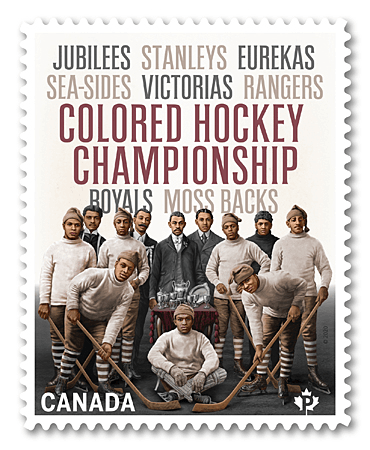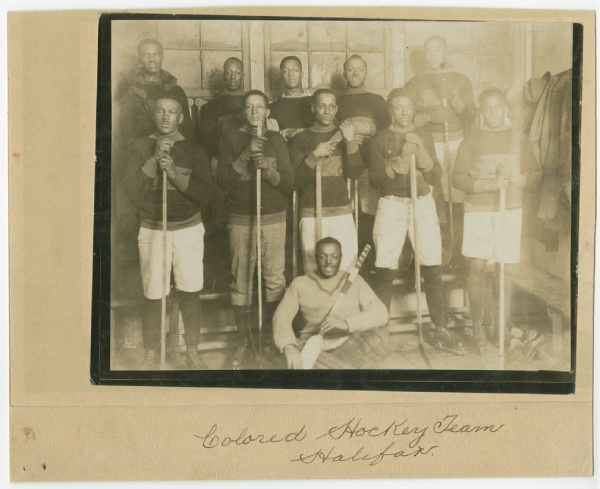Colored Hockey League of the Maritimes National Historic Event

© Canada Post Corporation / Library and Archives Canada
The Colored Hockey League of the Maritimes was designated as a national historic event in 2024.
Historical importance: maritime segregated competitive hockey league, only league of its kind in Canada and in the world in the early 1900s, illustrates how African Canadian communities fought for equality in sports and social change in Canada.
Commemorative plaque: no plaque installedFootnote 1
Colored Hockey League of the Maritimes
Created in 1895 in Halifax, Nova Scotia, the Colored Hockey League of the Maritimes (CHL) evolved from a small ice hockey league formed by African United Baptist Association leaders into a competitive all-Black Maritime hockey league. During its 30-year existence, a total of 12 teams and hundreds of men played in the league. They entertained multiracial crowds and impressed mainstream journalists who reported on their fast and innovative brand of hockey. The league and its players, however, endured racism on and off the ice that, coupled with economic and wartime factors, led to the league’s disbandment in 1925. Still, with the rising popularity of organized ice hockey in Canada in the early 20th century, this segregated league was the only league of its kind in Canadian history. The league illustrates how African Canadian communities in the Maritimes fought for equality in sports and used hockey to advance social change in Canada.
In 1895, Black Baptist leaders in Halifax created three teams (the Eurekas, the Jubilees, and the Stanleys) associated with two churches to attract young men of African descent to Sunday worship and foster a sense of pride within the community, and more teams were formed over the next couple of decades. During this time, overt anti-Black racism influenced the few existing hockey leagues to bar Black players from joining their teams. At the same time, the league and its players faced many barriers, including limited access to indoor rinks and ice time. This meant that CHL games were often played in poor conditions.

© Tom Connors Collection / Nova Scotia Archives / 1987-218 no 133 / negative N-1726
Despite these challenges, at its zenith between 1900 and 1905, the CHL was highly competitive and expanded throughout Nova Scotia and into Prince Edward Island. CHL matches attracted large and multiracial crowds. It was most unusual at the time for white spectators to attend all-Black sporting events. The CHL also attracted the attention of the press. Journalists for the widely read Acadian Reporter and the Truro Daily News reported on the CHL’s fast, physical, and innovative brand of hockey. The Dartmouth Jubilees’ original goaltender, Henry Franklyn, introduced the butterfly style of goaltending in 1900, and around that time the Halifax Eurekas’ Eddie Martin began using the slapshot. That was before these techniques seem to have been permitted in other Canadian leagues, and decades before the slapshot was introduced in the National Hockey League (NHL).
At the same time, under the management of James A. R. Kinney and James Robinson Johnston, early 20th-century leaders for the advancement and equality of Black Nova Scotians, the league also served as a means for effecting social change. But in 1905–1906, a major dispute pitted leaders of the African Canadian community against landowners and the Halifax administration when railway companies wanted to run tracks through the seaside community of Africville, resulting in the CHL losing ice time and media coverage.
The CHL faltered during the First World War, as did many other sports leagues whose members served overseas. It was revived in 1921. The continued racism and hardships the league and its players faced on and off the ice, however, eventually led to the league’s decision to disband in 1925. Some teams continued to compete into the 1930s under the auspices of other leagues. CHL players inspired generations of Black youth to hone their athletic skills and, eventually, to compete at the highest levels.
“The Government of Canada's recognition of the Colored Hockey League of the Maritimes (CHLM) as an event of historical significance entrenches its importance in Canadian hockey history. The league, through its highly talented players, who defied the established racist myths about their abilities and intelligence to play hockey, helped revolutionize the game as we know it today with their style of play and innovations such as the butterfly-style of goaltending and the slap shot. This recognition provides an excellent opportunity for all Canadians to learn more about the CHLM's history."
This press backgrounder was prepared at the time of the Ministerial announcement in 2024.
The National Program of Historical Commemoration relies on the participation of Canadians in the identification of places, events and persons of national historic significance. Any member of the public can nominate a topic for consideration by the Historic Sites and Monuments Board of Canada.
Related links
- National historic designations
- National historic persons
- National historic sites designations
- National historic events
- Submit a nomination
- Artifactuality Podcast: Breaking Ice – The Story of the Coloured Hockey League of the Maritimes (Canadian Museum of History)
- Breaking Racial Barriers in the National Hockey League National Historic Event
- This Week in History
- Date modified :